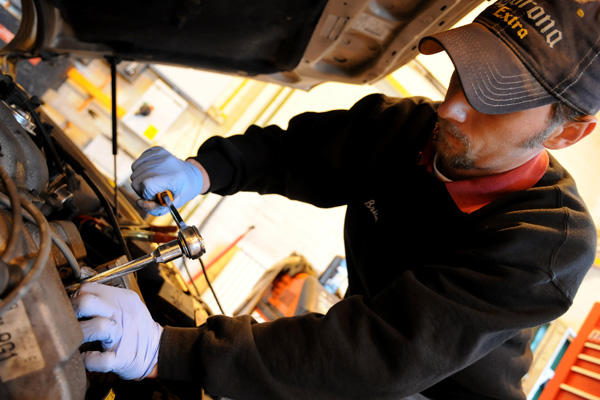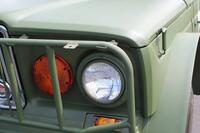Before you undertake any of this work, re-read the article "Deciding if you should do the job yourself," and if your vehicle fits even one of those descriptions, don't try to do the work in this section. It's better to pay a professional than to risk damaging your engine or ECU!
One way to royally confuse yourself and turn the relatively simple task of changing spark plugs into a nightmare is to pull all your spark plugs out at one time. To keep your sanity and to avoid turning this job into an allweekend project, work on one spark plug at a time: Remove it, inspect it, clean it, and — if it's salvageable — gap it. Then replace it before you move on to the next spark plug in cylinder sequence order. To maintain the proper firing order, each spark-plug wire must go from the spark source to the proper spark plug. Therefore, only remove the wire from one plug at a time, and don't disconnect both ends of the wire! This way, you won't ever get into trouble — unless a second wire comes off accidentally.
Follow these steps to remove each spark plug:
1. Gently grasp a spark plug wire by the boot (the place where it connects to the spark plug), twist it, and pull it straight out.
Never yank on the wire itself (you can damage the wiring). The shiny thing sticking out of the engine block after you remove the wire from the spark plug is the terminal of the spark plug.
|
Getting to Hard-to-Reach Plugs With all the stuff crammed under the hoods of vehicles, it can be hard to get at some spark plugs and, even when you can reach them easily, they may be difficult to remove. Here are some tips on extracting these spark plugs:
|
2. Use a soft, clean rag or a small paintbrush to carefully clean around the area where the spark plug enters the block. You also can blow thedirt away with a soda straw.
Cleaning the area keeps loose junk from falling down the hole into the cylinder when you remove the plug.
3. Place your spark plug socket (the big one with the rubber lining) over the spark plug; exert some pressure while turning it slightly to be sure that it's all the way down.
Like everything else in auto repair, don't be afraid to use some strength. But do it in an even, controlled manner. If you bang or jerk things, you can damage them, but you'll never get anywhere if you tiptoe around.
4. Stick the square end of your ratchet handle into the square hole in the spark plug socket.
You may work more comfortably by adding a couple of extensions between the handle and the socket so that you can move the handle freely from side to side without hitting anything. Add them in the same way you added the socket to the handle. If a plug is hard to reach, the sidebar "Getting to hard-to-reach plugs" gives you additional tips.
|
Mastering the Mighty Ratchet Ratchet handles can be a bit tricky if you've never used one. When you figure out how yours works, it will make many jobs much easier. The little knob on the back of the ratchet handle causes the ratchet to turn the socket either clockwise or counterclockwise. You can tell which way the handle will turn the plug by listening to the clicks that the handle makes when you move it in one direction. If it clicks when you move it to the right, it will turn the socket counterclockwise when you move it, silently, to the left. If the clicks are audible on the leftward swing, it will move the socket clockwise on the rightward swing. Every screw, nut, bolt, screw-on cap, and so on that you encounter should loosen counterclockwise and tighten clockwise ("lefty loosey, righty tighty"). If your ratchet clicks in the wrong direction, just move that little knob to reverse the direction. Figure 6-2 shows you the proper way to use a ratchet handle. |
5. Loosen the spark plug by turning it counterclockwise.
To get the proper leverage, place your free hand over the head of the wrench, grasping the head firmly, and pull the handle, hitting it gently with the palm of your hand to get it going (see Figure 6-2).
Caution: It's okay to exert some strength; just be sure your socket is securely over the plug and that the ratchet is at the same angle as the plug to avoid stripping the threads on the plug or in the spark plug hole in the engine head.
Tip: You may have some difficulty loosening a spark plug for the first time. Grease, sludge, and other junk may have caused the plug to stick in place, especially if it's been a long time since it was changed. If it feels stuck, try a little spray lubricant. You'll feel better knowing that after you've installed your new plugs by hand, it will be a lot easier to get them loose the next time. So persevere. I've never met a plug that didn't give up and come out, eventually.
6. When the ratchet turns freely, finish the job by removing the ratchet handle and turning the socket by hand until the plug is free from the engine.
Remember: After you remove the spark plug from the engine, remove the plug from thesocket.
From Auto Repair for Dummies, copyright © 2009 by Wiley Publishing, Inc., Indianapolis, Indiana. Used by arrangement with John Wiley & Sons, Inc.










